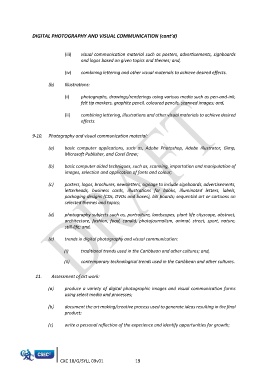Page 1420 - SUBSEC October 2017_Neat
P. 1420
DIGITAL PHOTOGRAPHY AND VISUAL COMMUNICATION (cont’d)
(iii) visual communication material such as posters, advertisements, signboards
and logos based on given topics and themes; and,
(iv) combining lettering and other visual materials to achieve desired effects.
(b) Illustrations:
(i) photographs, drawings/renderings using various media such as pen-and-ink,
felt tip markers, graphite pencil, coloured pencils, scanned images; and,
(ii) combining lettering, illustrations and other visual materials to achieve desired
effects.
9-10. Photography and visual communication material:
(a) basic computer applications, such as, Adobe Photoshop, Adobe Illustrator, Gimp,
Microsoft Publisher, and Corel Draw;
(b) basic computer aided techniques, such as, scanning, importation and manipulation of
images, selection and application of fonts and colour;
(c) posters, logos, brochures, newsletters, signage to include signboards, advertisements,
letterheads, business cards, illustrations for books, illuminated letters, labels,
packaging designs (CDs, DVDs and boxes), bill boards; sequential art or cartoons on
selected themes and topics;
(d) photography subjects such as, portraiture, landscapes, plant life cityscape, abstract,
architecture, fashion, food, candid, photojournalism, animal, street, sport, nature,
still-life; and,
(e) trends in digital photography and visual communication:
(i) traditional trends used in the Caribbean and other cultures; and,
(ii) contemporary technological trends used in the Caribbean and other cultures.
11. Assessment of art work:
(a) produce a variety of digital photographic images and visual communication forms
using select media and processes;
(b) document the art making/creative process used to generate ideas resulting in the final
product;
(c) write a personal reflection of the experience and identify opportunities for growth;
CXC 18/G/SYLL 09v01 19

